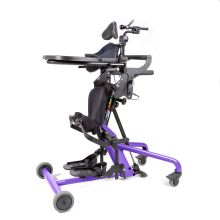Everybody Needs to Stand
Research indicates that every body benefits from standing whether you have a typical body or a body that requires special care. Respiration, circulation, digestion and ultimately a person’s overall sense of wellbeing is profoundly impacted by being given the opportunity to stand. Of special significance is offering a growing and developing body the chance to stand. Upright standing with weight bearing through the legs at an age-appropriate time in a child’s development is essential, regardless of whether the child can achieve this milestone on their own. Clinical research has shown that normal development of bones and muscles in growing children requires weight bearing. In fact, standing facilitates the formation of the hip joint in early development. So how do we get people who need a lot of support up on their feet for extended periods of time so they can reap the benefits of standing? Standers!
Many Different Styles of Special Needs Standers
Adult and pediatric standers are offered in a wide variety of styles. Understanding Prone vs. Supine Standing is a good place to start learning about the basics of these styles. The support surface of a Prone Stander is in front of the person using the stander. The angle of the stander is adjustable from upright forward towards the horizontal (leaning forward). The support surface of a Supine Stander is behind the person using the stander. The angle is adjustable from upright, backwards towards the horizontal (leaning backwards). Vertical Standers provide upright support and vertical alignment from feet to hips while still allowing freedom of movement of the head, trunk, and upper extremities in all directions.
Sit-to-Stand Standers are designed to offer therapeutic support in both sitting and standing positions. The person transfers into the piece of equipment configured as a seat. Then the equipment assists with the transition between sitting and standing. For even more versatility, choose one of our Three-Way Standers that adjusts between prone, supine and vertical standing positions. The EasyStand Zing Stander is able to incorporate abduction of the hips (legs moved away from midline) into standing. Because there are so many different types of standers and sizing can be somewhat complicated, we always encourage parents and therapists to give us a call at 800-371-2778 for one-on-one advice.













